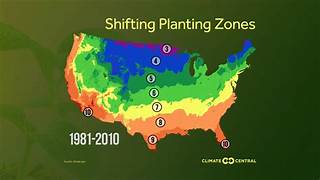
by Bill Schlesinger
Most seed catalogs tell amateur gardeners what to plant each spring by including a map of plant hardiness zones. Developed by the USDA, these maps show where certain species are likely to grow best. Those that flourish are largely determined by their physiological characteristics—how tolerant they are to high and low temperatures and what is the required length of the growing season to ensure flowering.
Climate also determines the natural vegetation on the landscape, with soil characteristics such as fertility playing a lesser role. For instance, hemlock is not found where winter temperatures do not fall below -28.8 C, since that is what kills the hemlock woolly adelgid, which infects hemlock. In the desert Southwest, creosote bush doesn’t grow north of the frost-free zone, inasmuch as winter frost interferes with its ability to transport water. As is the case for cultivars, the distribution of natural species is largely determined by physiology.
Changes in climate, and thus climate zones, will move plant hardiness zones northward and impact what we can grow in gardens. Less frequently discussed are changes in the distribution of natural vegetation that can be expected with climate change, both temperature and rainfall. The National Park Service feels this acutely, since it is charged with preserving natural heritage sites across the United States in the condition in which they were always found—vegetation, wildlife, soils, rocks, and waters. For more than 100 years that meant doing nothing to the landscape, other than curbing external abuses by humans. But what should the Park Service do now that the vegetation is changing dramatically due to exogenous factors. We’ve been here before when the Great Smoky Mountains Park lost American Chestnut.
With climate change, how will Park biologists know what species will be present at a particular location in the future? Perhaps a species that we now consider invasive is actually one that is destined to be the dominant native form in the new climate of the future. While seed companies and foresters transport commercially important species to new, favorable habitats, who will ensure that all the proper native species will be distributed to new sites across great distance? Many of the communities of species in parks are the result of thousands of years of coevolution. With the onset of climate change, entirely new groupings of species are expected, with no likelihood that they have a past history of cooccurrence.
I am usually skeptical of computer models, but this may be a case for the use of artificial intelligence (AI) to compile the physiological characteristics of all the tree species involved and data from past studies of their dispersal, establishment, and competitive relationships in new environments. Changes in the frequency of fire are also involved.
A few decades from now, when Acadia has no Red Spruce and Yosemite has no Sequoia, we will want to feel that the Park Service has done its best for the future.
References:
Dukes, J.S. et al. 2009. Response of insect pests, pathogens, and invasive plant species to climate change in the forests of northeastern North America. Canadian Journal of Forest Research 39: 231-248.
Fisichelli, N.A., S.R. Abella, M. Peters, and F.J Krist. 2014. Climate, trees, pests, and weeds: Change, uncertainty, and biotic stressors in eastern U.S. national park forests. Forest Ecology and Management 327: 31-39.
Iverson, L.R. and A.M. Prasad. 1998. Predicting abundance of 80 tree species following climate change in the eastern United States. Ecological Monographs 68: 465-489
Pockman, W.T. and J.S. Sperry. 1997. Freezing-induced xylem cavitation and the northern limit of Larrea tridentata. Oecologia 109: 19-27.
Sharma, S. and 44 others. 2022. North American tree migration paced by climate in the West, lagging in the East. Proceedings of the National Academy of Sciences 119: (3):
Stephenson, N.L. and 6 others. 2018. Patterns and correlates of giant sequoia foliage dieback during California’s 2012-2016 hotter drought. Forest Ecology and Management 419: 268-278.
- W. Williams, S. T. Jackson, J. E. Kutzbach. 2007. Projected distributions of novel and disappearing climates by 2100 AD. Proc. Natl. Acad. Sci. U.S.A.104: 5738–5742.